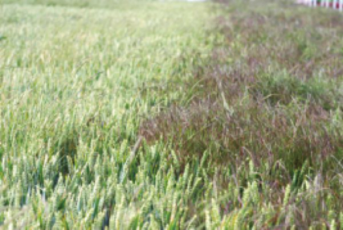 An increasing problem which favours continuous winter cereals and min till cultivation. It has the potential to be very invasive and can lodge crops when in large numbers. At present brome is towering above the barley and wheat crops. Small patches should not be ignored as it can turn into a severe problem quickly if ignored as up to 2000 seeds are produced per plant!. Brome is easily identifiable with purple / reddish heavy drooping spikelet’s approx 1 inch in length.
An increasing problem which favours continuous winter cereals and min till cultivation. It has the potential to be very invasive and can lodge crops when in large numbers. At present brome is towering above the barley and wheat crops. Small patches should not be ignored as it can turn into a severe problem quickly if ignored as up to 2000 seeds are produced per plant!. Brome is easily identifiable with purple / reddish heavy drooping spikelet’s approx 1 inch in length.
It can be difficult to eliminate, however its burden can be tolerated at low levels with the use of chemical controls in wheat, eg: Brodaway Star and Pacifica. There are currently no chemical brome controls for winter barley and Oats.
CONTROL OPTIONS:
- Cultural controls, are the most economic method of control. Shallow cultivate after harvest to encourage germination of seeds, once germinated spray with glyphosate or plough.
- Ploughing: Plough to a depth of at least 6 inches, it is all important to ensure inversion of the furrow completely burying the seed.
- Allow for a wider or narrower headland when ploughing as accumulations tend to thrive where the plough is lifted out at the headland, this is due to poor burial of the seeds in this particular area.
- Limit the spread of seeds by ensuring harvesting and bale machines are free from brome.
- Use certifited seed, the Dept of Agriculture & Irish Seed Trade Association have adopted a zero – tolerance approach to Brome grasses. Certified seed is brome free.
- Rotation, a non cereal break crop allows a wider range of herbicides to tackle the problem.
- A spring crop allows a stale seedbed over winter.
- Try to avoid continuous winter barley.
Our agronomists are available to identify Brome and other grass weeds and discuss options going forward. It is best to make a plan now rather than wait for chemical solutions later.


